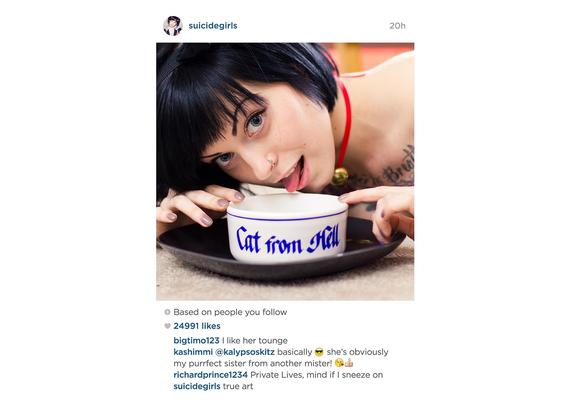Nearly all artists take inspiration from the works of other artists. Or in the words of the legendary blues musician, Blind Willie McTell, "I jump 'em from other artists, but I arrange 'em my own way."
What happens when an artist doesn't collage, mash-up, remix or rearrange someone else's art and just takes it, mildly tweaks it, and then calls it his own original work? Ask the controversial appropriation artist Richard Prince.
In recent years, four different artists have sued Prince and his now-former gallery (Gagosian) for wrongfully creating reproductions without consent. Here is how it works for Prince as observed in his latest project, the New Portrait series. Prince screenshots web images of provocatively posed women he finds on Instagram, blows up the ink jet print portraits onto a 6' canvas, adds obscure captions, then exhibits and sells them through his gallery at $90k a pop. All without permission or providing compensation, recognition or attribution of the women whose selfie images he appropriates.
Is what Prince doing legal? One of the core benefits the owner of a copyright has is the exclusive right to make copies or reproductions of the original work of art. This applies to any rearrangement, recasting or translation of a copyrighted work. A straightforward example of this derivative right is turning a comic book into a movie. Yet, what of an artist like Prince who enlarges the images, prints them on canvas, and adds text to the more significant creative art of the original copyright owner? Should society recognize a copyright in Prince's newly created work or has he infringed upon the reproduction right of the owner of the Instagram selfies?
The notion of what constitutes a copyright infringement is not always easy to decipher. On paper the legal test for wrongful use is straightforward: whether an ordinary person while examining the original work and the alleged copied work side by side, would conclude that the second work is indeed copied from the original work. Contrary to the common opinion there is no fixed percent rule that when more than X,Y or Z percent of the original work is used there must be a finding of infringement. The legal analysis requires an examination of both qualitative and quantitative factors.
In determining whether Prince's use of the copyrighted selfies is a fair use protected by copyright law there are four guideposts to consider. Did Prince make any money from his new art venture? The quick answer is a resounding YES. He didn't create this art for education reasons. Is the nature of the copied print similar to the copyrighted selfie? Once more, the response is in the affirmative. Both are portraited images, although Prince may argue his canvas print is a different medium than a digital image. How much of the original art did Prince use? He used the whole of it not a mere portion of the original. What impact did Prince's art have on the real or potential market value of the original selfie? Unlike the other three factors, here Prince can justly make an argument in this favor. His creations brought attention to the Instagram images of the pin-up Suicide Girls models and the makeup artist, Ashley Salazar aka Mynxii White, who most recently sued Prince, that serve to enhance the value of their original works, not diminish it.
Besides examining each of these four factors individually, courts also will holistically assess whether Prince's art sufficiently transforms the original artwork by giving it a different meaning to qualify as a fair use.
Prince is not the first artist who seeks to reimage existing works of art for commercial purposes. Andy Warhol's silkscreen image of Marilyn Monroe, Roy Lichtenstein's parodied compositions of Mickey Mouse, and Shepard Fairey's HOPE poster of Obama based on a copyrighted photograph are examples of a venerable tradition in modern art that Prince is next-in-line to follow. However, in an age where copyrighted images are easily licensed or sold for megabucks, the stakes are higher today than ever before.
In what may be a better response to actually suing Prince, Missy Suicide, one of the proprietors of the online SuicideGirls website, elected to retaliate against Prince. She created her own appropriated version of Prince's appropriation of the original copyrighted selfie. For $90, not the aforementioned $90,000, anyone may buy her 6' print that includes a tongue-in-cheek comment on Prince's original source material in the final text line. You decide, is she now stealing the art of another artist?
